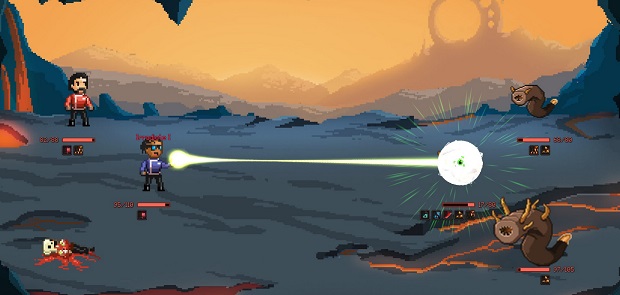Wot I Think: Halcyon 6 - Starbase Commander
Star Trek meets XCOM
One minute, Halcyon 6 [official site] reminds me of XCOM, but with spaceships as well as people, and the next it reminds me of every JRPG I've ever abandoned. Every now and again I think everything is clicking into place, and there's a little bit of Star Control flavouring, but before long I find another piece of busywork to take up my time.
I keep asking myself whether the good side of Starbase Commanding outweighs the occasional bout of tedium. Here's wot I think.
In Halcyon 6, you start off on the back-foot. Sure, you're in command of a starbase and it's a potentially awesome starbase, but there are pirates and what appear to be extra-dimensional nasties coming to feast on you and the rest of your federation. The pirates have formed a union of sorts, and smashing that to pieces is one of the first challenges you'll face. The non-human nasties are altogether more troublesome and mysterious, taking on various forms, all of which land somewhere on the cosmic horror spectrum. One of them looks like an angry asteroid with a face.
Despite all of their tentacles and other bits, both bulging and blade-like, these space beasties aren't particularly dreadful. Dangerous, yes, but also kind of adorable. Halcyon makes cosmic horror cute, and even when one of your hastily 'volunteered' red green shirts splits apart at the seams after taking one too many globs of acidic spit to the torso, the whole thing still feels like it could fit in a block of Toonami programming.
Combat takes place in both ship-to-ship (or ship-to-monster) forms and down on the surface, where your officers and hapless crew members fight use phasers, lasers, hacking devices and much more. Whether you're in space or on the ground, fights are turn-based JRPG style affairs, which is to say units act in a set order and can choose from several abilities, either buffing, causing detrimental status effects, chipping away at health or healing. Or any combination of those things.
The aim – aside from actually killing your enemies – is to use combos, whereby you exploit vulnerabilities and apply status effects that you can then exploit even further. You might be able to confuse a hostile, for example, which provides benefits of its own, and then use another ability that capitalises on the confusion, causing more damage than it normally would.
It's all fine. Enjoyable enough and presented pleasantly, but incapable of creating the kind of dramatic tension that comes from a more kinetic squad-based skirmish. The lasting impression is of two teams of three lining up and slowly whittling away at one another, which is precisely what's shown on screen. Combat is mostly about preparation, you see – take a team with complementary abilities and you're likely to succeed much more quickly, and with less wounds to spend your hard-earned healing after the fact.
Preparation is where the starbase comes in.
It once belonged to one of those precursor races who leave their toys scattered across so many of the galaxies that live on the science fiction shelf, so it has all kinds of secrets to uncover and maybe even a god-shattering weapon tucked in one of its crevices. Think something between Farscape's Moya - a sentient bio-mechanical ship - and XCOM 2's reclaimed alien tech that must be cleared out room by room.
The side-on view of the starbase is where the first of the XCOM comparisons comes in. It'll look immediately familiar to anyone who has played Firaxis' games, the sequel in particular given how alien and wierd-tech everything looks, and you'll be building officer training facilities and the like as well, so the comparison isn't even skin-deep.
I found the galactic map trickier to get my head around. It doesn't look like a Geoscape but it behaves like a Geoscape. Notifications at the bottom right of the screen let you know when something requires your attention, you accelerate time or pause using buttons at the top, and ships travel back and forth to hotspots as directed. At first, you're mostly dealing with events as they unfold and as the game becomes more expansive, there's a lot of defending to be done (that starbase is a prime target for all kinds of foes).
Despite preparing for scenarios by upgrading the base and levelling up crew being vital, I've never quite felt like I have enough control to define my path through a campaign rather than simply reacting to problems as they arise. That's due to the busywork mentioned earlier, which is an important slice of the game's structure. Rather than simply building manufacturing rooms for the resources needed to build and upgrade, you'll gather many of them by completing missions, and by collecting them from various facilities scattered around the map.
If you've ever played a Heroes of Might and Magic game (and if you haven't, do yourself a favour and go play III) you'll recognise the way this works. Manufacturers make resources and you send heroes (officers in this case) trotting around the map to collect them. They only have limited storage space, those manufacturers, so you really want to stop by just as they've filled up, so as not to waste time and fuel on the visit. It's kind of like learning the spawn points and countdowns for weapons and armour on an FPS deathmatch map – you learn the route and time your pickups to perfection.
There are workarounds that allow you to spend your time and attention elsewhere, but you're going to be doing the collection rounds quite a lot in the early game, as you bring your tech and officers up to speed.
Halcyon does have peaks of excitement, usually linked to the big confrontations that crop up from time to time. Knowing that something powerful is heading toward the station and having to recall fleets and get everything running optimally before it arrives shows the game at its best – it's where it most resembles FTL in playstyle. FTL bolted onto a slightly broader strategy game.
Imagine – and stick with me here – that every game is a word and like a word it's made up of letters. Some are neologisms, others are simple but effective, communicating a great deal with a few letters. Then there are the ones that are a bit of a mouthful or that you can see the appeal of but would never use in conversation. I trip over Halcyon (both the game and the title; 'lcy' confuses my brain). The parts that feel like XCOM don't quite fit with the parts that feel like Heroes of Might and Magic, and the parts that feel like a JRPG don't fit with either.
The combination of features in Halcyon feels as if someone dipped their hand into a Scrabble bag and pulled out a handful of letters and then made one of those words that scores loads of points but that I'm not quite convinced is real. Muzjiks, say.
I'm not sure if I'd like the whole game a lot more if I hadn't played all of the things that it references. The fact that it's derivative doesn't bother me in the slightest – everything is – but this particular combination of things that I like (or in the case of the combat, a thing that I can tolerate) adds up to something that makes me want to turn back to its inspirations rather than stick with it.
If XCOM and Heroes of Might and Magic meets Star Trek/Farscape appeals to you (it does, doesn't it?), and you're happy to force your way past some initially confusing issues with the interface, you'll almost certainly enjoy Halcyon 6. I have, despite my gripes, but it's less than the sum of all those parts that I couldn't help but see the edges of as I played, and I was longing for more engaging combat long before the end. Even if the galaxy continues to grow, I don't think I'll return even.
Halcyon 6 is available now, for Windows, Mac and Linux, and is available through Steam.
















